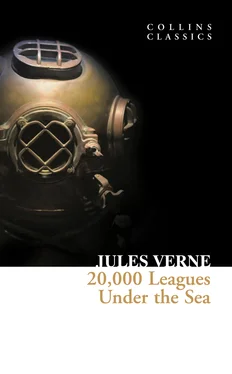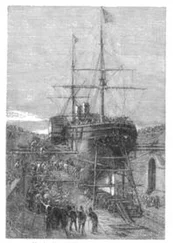‘Captain Nemo,’ I replied, ‘I recognise the results, and do not seek to explain them. I saw the Nautilus worked in the presence of the Abraham Lincoln , and I know what to think of its speed. But it is not enough to be able to walk; you must see where you are going; you must be able to direct yourself to the right or left, above or below. How do you reach the great depths, where you find an increasing resistance, which is rated by hundreds of atmospheres? How do you return to the surface of the ocean, or maintain yourself at the proper depth? Am I indiscreet in asking you this question?’
‘Not at all, professor,’ answered the captain, after a slight hesitation. ‘As you are never to leave this submarine boat, come into the saloon – it is our true study – and there you shall learn all you want to know about the Nautilus .’
A moment afterwards we were seated on a divan in the saloon, with our cigars. The captain spread out a diagram that gave the plan of the Nautilus . Then he began his description in these terms: –
‘Here, M. Aronnax, are the different dimensions of the vessel you are in. It is a very elongated cylinder, with conical ends much like a cigar in shape. The length of this cylinder is exactly 232 feet, and its maximum breadth is 26 feet. Its lines are sufficiently long, and its slope lengthened out to allow the displaced water to escape easily, and opposes no obstacle to its speed. Its surface is 1011 metres and 45 centimetres; its volume, 1500 cubic metres and two-tenths, which is the same as saying that it is entirely immersed. It displaces 50,000 feet of water, and weighs 1500 tons.
‘When I made the plans for this vessel – destined for submarine navigation – I wished that when it was in equilibrium nine-tenths of it should be under water, and one-tenth only should emerge. Consequently, under these conditions, it only ought to displace nine-tenths of its volume, or 1356 cubic metres and 48 centimetres – that is to say, it only ought to weigh the same number of tons. I therefore did not exceed this weight in constructing it according to the above-named dimensions.
‘The Nautilus is composed of two hulls, one inside the other, and joined by T-shaped irons, which make it very strong. Owing to this cellular arrangement it resists as if it were solid. Its sides cannot yield; they adhere spontaneously, and not by the closeness of their rivets; and the homogeneity of their construction, due to the perfect union of the materials, enables my vessel to defy the roughest seas.
‘Then when the Nautilus is afloat, one-tenth is out of the water. I have placed reservoirs of a size equal to this tenth capable of holding 150.72 tons, and when I fill them with water the vessel becomes completely immersed. These reservoirs exist in the lowest parts of the Nautilus . I turn on taps, they fill, and the vessel sinks just below the surface of the water.’
‘Well, captain, I can understand your being able to keep just level with the surface of the ocean. But lower down, when you plunge below that surface, does not your submarine apparatus meet with a pressure from below, which must be equal to one atmosphere for every thirty feet of water?’
‘True, sir.’
‘Then unless you fill the Nautilus entirely, I do not see how you can draw it down into the bosom of the liquid mass.’
‘Professor,’ answered Captain Nemo, ‘you must not confound statics with dynamics, or you will expose yourself to grave errors. There is very little work necessary to reach the lowest depths of the ocean, for bodies have a tendency “to sink.” Follow my reasoning.’
‘I am listening to you, captain.’
‘When I wished to determine the increase of weight that must be given to the Nautilus to sink it, I had only to occupy myself with the reduction in volume which sea-water experiences as it becomes deeper and deeper.
‘Now if water is not absolutely incompressible, it is, at least, very slightly compressible – in fact, according to the most recent calculations .0000436 in an atmosphere or in each thirty feet of depth. If I wish to go to the depth of 1000 metres, I take into account the reduction of volume under a pressure of 100 atmospheres. I ought, therefore, to increase the weight so as to weigh 1513.79 tons instead of 1507.2 tons. The augmentation will only be 6.77 tons. Now I have supplementary reservoirs capable of embarking 100 tons. When I wish to remount to the surface, I have only to let out this water, and empty all the reservoirs, if I desire that the Nautilus should emerge one tenth of its total capacity.’
To this reasoning, founded upon figures, I had nothing to object.
‘I admit your calculations, captain,’ I replied, ‘and I should be foolish to dispute them, as experience proves them every day, but I foresee a real difficulty.’
‘What is that, sir?’
‘When you are at the depth of 1000 yards the sides of the Nautilus support a pressure of 100 atmospheres. If, therefore, at this moment, you wish to empty the supplementary reservoirs to lighten your vessel and ascend to the surface, the pumps must conquer this pressure of 100 atmospheres, which is that of 100 kilogrammes for every square centimetre. Hence a power –’
‘Which electricity alone can give me,’ hastened to say Captain Nemo. ‘The dynamic power of my machines is nearly infinite. The pumps of the Nautilus have prodigious force, which you must have seen when their columns of water were precipitated like a torrent over the Abraham Lincoln . Besides, I only use supplementary reservoirs to obtain middle depths of 1500 to 2000 metres, and that in order to save my apparatus. When the fancy takes me to visit the depths of the ocean at two or three leagues below its surface, I use longer means, but no less infallible.’
‘What are they, captain?’ I asked.
‘That involves my telling you how the Nautilus is worked.’
‘I am all impatience to hear it.’
‘In order to steer my vessel horizontally I use an ordinary rudder, worked by a wheel and tackle. But I can also move the Nautilus by a vertical movement, by means of two inclined planes fastened to the sides and at the centre of flotation, planes that can move in every direction, and are worked from the interior by means of powerful levers. When these planes are kept parallel with the boat it moves horizontally; when slanted, the Nautilus , according to their inclination, and under the influence of the screw, either sinks according to an elongated diagonal, or rises diagonally as it suits me. And even when I wish to rise more quickly to the surface I engage the screw, and the pressure of the water causes the Nautilus to rise vertically like a balloon into the air.’
‘Bravo! captain,’ I cried. ‘But how can the helmsman follow the route you give him in the midst of the waters?’
‘The helmsman is placed in a glass cage jutting from the top of the Nautilus and furnished with lenses.’
‘Capable of resisting such pressure?’
‘Perfectly. Glass, which a blow can break, offers, nevertheless, considerable resistance. During some fishing experiments we made in 1864, by electric light, in the Northern Seas, we saw plates less than a third of an inch thick resist a pressure of sixteen atmospheres. Now the glass that I use is not less than thirty times thicker.’
‘I see now. But, after all, it is dark under water; how do you see where you are going?’
‘There is a powerful electric reflector placed behind the helmsman’s cage, the rays from which light up the sea for half a mile in front.’
‘Ah, now I can account for the phosphorescence in the supposed narwhal that puzzled me so. May I now ask you if the damage you did to the Scotia was due to an accident?’
Читать дальше












